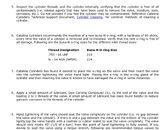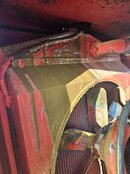You are using an out of date browser. It may not display this or other websites correctly.
You should upgrade or use an alternative browser.
You should upgrade or use an alternative browser.
Can't get the valves off my steel tanks
- Thread starter lhpdiver
- Start date
Please register or login
Welcome to ScubaBoard, the world's largest scuba diving community. Registration is not required to read the forums, but we encourage you to join. Joining has its benefits and enables you to participate in the discussions.
Benefits of registering include
- Ability to post and comment on topics and discussions.
- A Free photo gallery to share your dive photos with the world.
- You can make this box go away
To each what? O-ring or valve?Yes, i skip read that one as i am packing for a trip. My mistake.
However, Catalina....View attachment 852862
Boarderguy
Chief Narctopus Wrangler
I really don't care, this is just fun for me. I whack mine with the palm of my hand to get them to turn. What my LDS does when I pay the scuba tax is not my concern.Yes, i skip read that one as i am packing for a trip. My mistake.
However, Catalina....View attachment 852862
Still Kicking
Contributor
Like I said, do whatever works for you -- scuba police enforcement is very lax -- but don't make stuff up about what the manufacturers say.I really don't care, this is just fun for me. I whack mine with the palm of my hand to get them to turn. What my LDS does when I pay the scuba tax is not my concern.
I'm done on this and ready to go diving!
Gone for diving
Contributor
bakodiver391
Contributor
Here's a trick I came up with. If the shop has a compressor, fill the tank normally to full pressure. Then open the valve and vent the tank quickly. The valve will freeze solid, the tank will cool off but not freeze. The temperature differential will open up tolerances in the threads and sometimes allow the valve to easily unscrew. Do this as the tank is empty but the valve is still frozen. You can also carefully pour hot water around the tank crown, not getting any on the valve. This doesn't work all the time but often enough to make it worthwhile.
On the lubrication issue, if there are water droplets in your tank, you're doing it wrong and your tanks are probably ruined.
On the lubrication issue, if there are water droplets in your tank, you're doing it wrong and your tanks are probably ruined.
Strange.He seems really hung up on 'lubricant'.
Are these tank valves of the old V shape that you need to seal with isolation tape and not with an o-ring?I don't know. The tanks are perhaps 20 years old (he has them at the moment). But they have been pampered (in a closet) for the last 2 years...
Tanks A Lot
Contributor
[...]If the shop has a compressor, fill the tank normally to full pressure. Then open the valve and vent the tank quickly. The valve will freeze solid, the tank will cool off but not freeze. The temperature differential will open up tolerances in the threads and sometimes allow the valve to easily unscrew. Do this as the tank is empty but the valve is still frozen.[...]
I cannot recommend this practice for a couple of reasons.
- If the valve is hard to undo, it could indicate moisture ingestion into the cylinder. By rapidly emptying the cylinder, this water will freeze and block the cylinder valve. Depending on water content and valve type, I have seen as much as 40 bar remaining in the cylinder. The devious part is that it appears to be empty as no more gas can escape due to the blockage. It takes half a minute or minute for the ice to weaken and melt to let some more gas escape. This process can repeat two or three times in extreme cases.
- Even if the cylinder was not wet at all, a careless technician might not just loosen the valve but fully remove it. The now much cooler cylinder compared to the environment will have a good deal of condense water on its inside wall developing. We have gotten a perfectly fine cylinder wet and have to dry it.
Yes, it is trivial to check if the valve is blocked or cylinder is empty, but we are adding some unnecessary risk for someone who might forget to do so.
I always recommend to let the cylinder come back to room temperature. This avoids both scenarios from above.
While in theory your suggestion works very well, the practical implications and uncertainties make this practice dangerous from my perspective.
bakodiver391
Contributor
I guess my trick takes a little dilligence. I find it easy to tell if a cylinder drains naturally or is suddenly blocked by ice. The second issue with condensation is valid, but assuming i get the valve out, I always immediately blast out the tank with a high flow of super-dried air to blow out and dry any condensation. Tank inverted and the hose all the way up inside the tank works very well. Then a sealed plastic cap until I am ready to re-install the valve. Essentially, a tank with a stuck valve is scrap metal anyway, so this is a last-ditch effort to keep it from the scrap heap. I've serviced thousands of tanks and own the better part of a hundred myself, and haven't had any safety issues yet.
.
.
- Messages
- 8,597
- Reaction score
- 7,302
- # of dives
- 2500 - 4999
Dude get a bigger carpet wrap it around your tank put it in the gutter and park your car on it

and no lube on threads just spit on the oring
AND ALWAYS dirECTLY HIT THE VALVE ALWAYS!
I’ve also wrestled on the ground with tanks laying on a little piece if carpet trying to get a wrench on them, holding them with my legs trying to stop them from spinning. In a perfect world a torsion cylinder strap with a long bar is used to hold the tank.
and no lube on threads just spit on the oring
AND ALWAYS dirECTLY HIT THE VALVE ALWAYS!
Similar threads
- Replies
- 3
- Views
- 198
- Replies
- 1
- Views
- 457
- Replies
- 1
- Views
- 456
- Replies
- 2
- Views
- 504
- Replies
- 109
- Views
- 9,839





